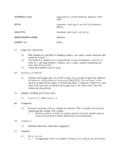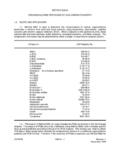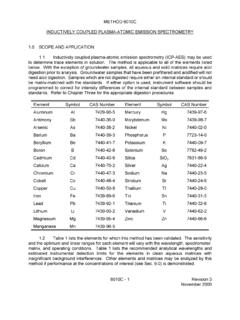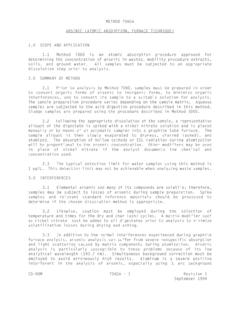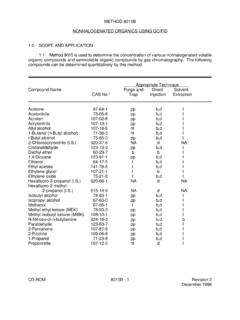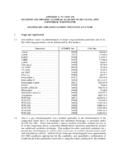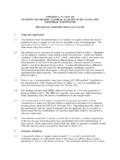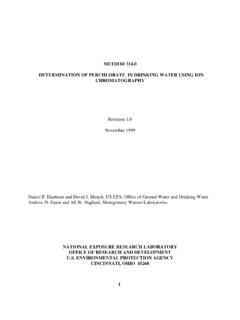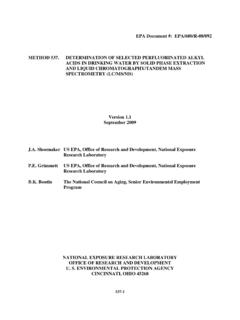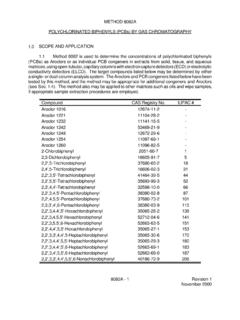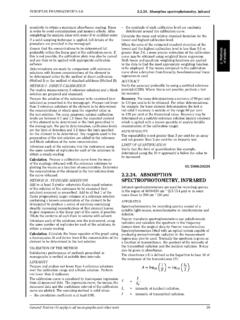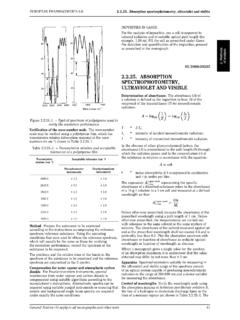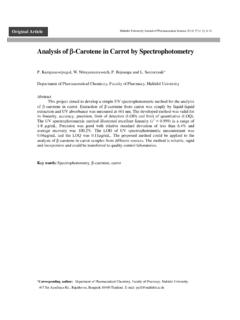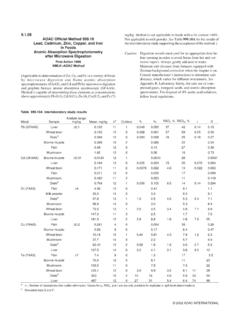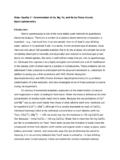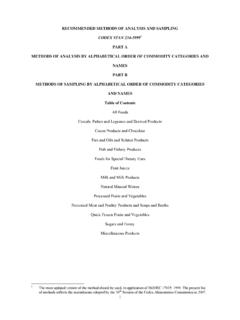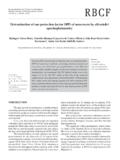Transcription of SW-846 Method 7000B: Flame Atomic Absorption …
1 7000b - 1 Revision 2 February 2007 Method 7000 BFLAME Atomic Absorption spectrophotometry SW-846 is not intended to be an analytical training manual. Therefore, methodprocedures are written based on the assumption that they will be performed by analysts who areformally trained in at least the basic principles of chemical analysis and in the use of the addition, SW-846 methods, with the exception of required Method use for the analysisof Method -defined parameters, are intended to be guidance methods which contain generalinformation on how to perform an analytical procedure or technique which a laboratory can useas a basic starting point for generating its own detailed Standard Operating Procedure (SOP),either for its own general use or for a specific project application. The performance dataincluded in this Method are for guidance purposes only, and are not intended to be and mustnot be used as absolute QC acceptance criteria for purposes of laboratory SCOPE AND in solution may be readily determined by Flame (direct aspiration) atomicabsorption spectrophotometry .
2 The Method is simple, rapid, and applicable to a large numberof environmental samples including, but not limited to, ground water, aqueous samples,extracts, industrial wastes, soils, sludges, sediments, and similar wastes. With the exception ofthe analyses for dissolved constituents, all samples require digestion prior to analysis (seeChapter Three). Analysis for dissolved elements does not require digestion if the sample hasbeen filtered and then : Organo-metallic species may not be detected if the sample is not digested. The following elements have been determined by this Method :ELEMENT CASRNa Aluminum(Al)7429-90-5 Antimony(Sb)7440-36-0 Barium(Ba)7440-39-3 Beryllium(Be)7440-41-7 Cadmium(Cd)7440-43-9 Calcium(Ca)7440-70-2 Chromium(Cr)7440-47-3 Cobalt(Co)7440-48-4 Copper(Cu)7440-50-8 Iron(Fe)7439-89-6 Lead(Pb)7439-92-1 Lithium(Li)7439-93-2 Magnesium(Mg)7439-95-4 Manganese(Mn)7439-96-5 Molybdenum (Mo)7439-98-7 Nickel(Ni)7440-02-0 Osmium(Os)7440-04-2 Potassium(K)7440-09-7 Silver(Ag)7440-22-47000B - 2 Revision 2 February 2007 Sodium(Na)7440-23-5 Strontium(Sr)7440-24-6 Thallium(Tl)7440-28-0 Tin(Sn)7440-31-5 Vanadium(V)7440-62-2 Zinc(Zn)7440-66-6 a Chemical Abstract Service Registry limits of quantitation and optimum ranges of the metals will vary with thematrices and models of Atomic Absorption spectrophotometers.
3 The data shown in Table 1provide some indication of the lower limits of quantitation obtainable by the direct aspirationtechnique. For clean aqueous samples, the quantitation limits shown in the table by directaspiration may be extended downward with scale expansion and upward by using a lesssensitive wavelength or by rotating the burner head. Quantitation limits by direct aspiration mayalso be extended through concentration of the sample and/or through solvent of this Method should state the data quality objectives prior to analysis andmust document and have on file the required initial demonstration performance data describedin the following sections prior to using this Method for analysis. direct-aspiration Atomic Absorption techniques do not provide adequatesensitivity, refer to specialized procedures such as graphite furnace Atomic Absorption (Method7010) or the gaseous-hydride Other elements and matrices may be analyzed by this Method as long as themethod performance is demonstrated for these additional elements of interest, in the additionalmatrices of interest, at the concentration levels of interest in the same manner as the listedelements and matrices (see Sec.)
4 To employing this Method , analysts are advised to consult each type ofprocedure ( , sample preparation methods) that may be employed in the overall analysis foradditional information on quality control procedures, development of QA acceptance criteria,calculations, and general guidance. Analysts also should consult the disclaimer statement atthe front of the manual and the information in Chapter Two for guidance on the intendedflexibility in the choice of methods, apparatus, materials, reagents, and supplies, and on theresponsibilities of the analyst for demonstrating that the techniques employed are appropriatefor the analytes of interest, in the matrix of interest, and at the levels of concern. In addition, analysts and data users are advised that, except where explicitly specified in aregulation, the use of SW-846 methods is not mandatory in response to Federal testingrequirements.
5 The information contained in this Method is provided by EPA as guidance to beused by the analyst and the regulated community in making judgments necessary to generateresults that meet the data quality objectives for the intended of this Method is restricted to use by, or under supervision of, properlyexperienced and trained personnel, including analysts who are knowledgeable in the chemicaland physical interferences described in this Method . Each analyst must demonstrate the abilityto generate acceptable results with this Method . 7000b - 3 Revision 2 February SUMMARY OF methods have been reported for the analysis of solids by atomicabsorption spectrophotometry , the technique generally is limited to metals in solution ordissolved through some form of sample processing (see Chapter Three). Preliminary treatmentof waste water, ground water, extracts, and industrial waste is always necessary because of thecomplexity and variability of sample matrix.
6 Solids, slurries, and suspended material must besubjected to a solubilization process before analysis. This process may vary because of themetals to be determined and the nature of the sample being analyzed. Solubilization anddigestion procedures are presented in Chapter direct-aspiration Atomic Absorption spectrophotometry , a sample is aspiratedand atomized in a Flame . A light beam from a hollow cathode lamp or an electrodelessdischarge lamp is directed through the Flame into a monochromator, and onto a detector thatmeasures the amount of absorbed light. Absorption depends upon the presence of freeunexcited ground-state atoms in the Flame . Because the wavelength of the light beam ischaracteristic of only the metal being determined, the light energy absorbed by the Flame is ameasure of the concentration of that metal in the sample.
7 This principle is the basis of atomicabsorption DEFINITIONSR efer to Chapter One, Chapter Three, and the manufacturer's instructions for a definitionsthat may be relevant to this , reagents, glassware, and other sample processing hardware may yieldartifacts and/or interferences to sample analysis. All of these materials must be demonstratedto be free from interferences under the conditions of the analysis by analyzing Method blanks. Specific selection of reagents and purification of solvents by distillation in all-glass systems maybe necessary. Refer to each Method to be used for specific guidance on quality controlprocedures and to Chapter Three for general guidance on the cleaning of most troublesome type of interference in Atomic Absorption spectrophotometryis usually termed "chemical" and is caused by lack of Absorption of atoms bound in molecularcombination in the Flame .
8 This phenomenon can occur when the Flame is not sufficiently hot todissociate the molecule, as in the case of phosphate interference with magnesium, or when thedissociated atom is immediately oxidized to a compound that will not dissociate further at thetemperature of the Flame . The addition of lanthanum will overcome phosphate interference inmagnesium, calcium, and barium determinations. Similarly, silica interference in thedetermination of manganese can be eliminated by the addition of calcium. A nitrousoxide/acetylene gas mixture may be used to help prevent interferences from interferences may also be eliminated by separating the metal from theinterfering material. Although complexing agents are employed primarily to increase thesensitivity of the analysis, they may also be used to eliminate or reduce presence of high dissolved solids in the sample may result in an interferencefrom non- Atomic absorbance such as light scattering.
9 In the absence of background correction,this can result in false positives and/or falsely elevated values. If background correction is not7000B - 4 Revision 2 February 2007available, a non-absorbing wavelength should be checked. Signal contribution fromuncorrected background can not be diagnosed through the analysis of spike recovery, nor is itcompensated for by the application of the Method of standard additions (MSA). If backgroundcorrection is not available and the non-absorbing wavelength test indicates the presence ofbackground interference, the sample digestates must be extracted (liquid-liquid or solid phase)prior to analysis, or another analytical Method must be selected. interferences occur when the Flame temperature is sufficiently high togenerate the removal of an electron from a neutral atom, giving a positively charged ion.
10 Thistype of interference can generally be controlled by the addition, to both standard and samplesolutions, of a large excess (1,000 mg/L) of an easily ionized element such as K, Na, Li or Cs. Each sample and standard should contain 2 mL KCl/100 mL of solution. Use 95 g of potassiumchloride in 1 L of reagent water for the KCl interference can occur when an absorbing wavelength of an elementpresent in the sample, but not being determined, falls within the width of the Absorption line ofthe element of interest. The results of the determination will then be erroneously high, due tothe contribution of the interfering element to the Atomic Absorption signal. Interference can alsooccur when resonant energy from another element in a multielement lamp, or from a metalimpurity in the lamp cathode, falls within the bandpass of the slit setting when that other metal ispresent in the sample.
